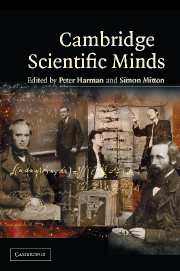Book contents
- Frontmatter
- Contents
- Foreword
- Introduction
- 1 William Gilbert
- 2 William Harvey
- 3 Isaac Newton: Creator of the Cambridge scientific tradition
- 4 William Whewell: A Cambridge historian and philosopher of science
- 5 Adam Sedgwick: A confident mind in turmoil
- 6 Charles Babbage: Science and reform
- 7 Charles Darwin
- 8 Stokes and Kelvin, Cambridge and Glasgow, light and heat
- 9 James Clerk Maxwell
- 10 The duo from Trinity: A.N. Whitehead and Bertrand Russell on the foundations of mathematics, 1895–1925
- 11 Thomson, Rutherford and atomic physics at the Cavendish
- 12 Hopkins and biochemistry
- 13 Charles Sherrington, E.D. Adrian, and Henry Dale: The Cambridge Physiological Laboratory and the physiology of the nervous system
- 14 Hardy and Littlewood
- 15 Arthur Stanley Eddington
- 16 Paul Dirac: A quantum genius
- 17 Alan Turing
- 18 Francis Crick and James Watson
- 19 Mary Cartwright
- 20 Joseph Needham
- 21 Molecular biology in Cambridge
- 22 The discovery of pulsars – prelude and aftermath
- 23 Stephen W. Hawking
16 - Paul Dirac: A quantum genius
Published online by Cambridge University Press: 05 June 2014
- Frontmatter
- Contents
- Foreword
- Introduction
- 1 William Gilbert
- 2 William Harvey
- 3 Isaac Newton: Creator of the Cambridge scientific tradition
- 4 William Whewell: A Cambridge historian and philosopher of science
- 5 Adam Sedgwick: A confident mind in turmoil
- 6 Charles Babbage: Science and reform
- 7 Charles Darwin
- 8 Stokes and Kelvin, Cambridge and Glasgow, light and heat
- 9 James Clerk Maxwell
- 10 The duo from Trinity: A.N. Whitehead and Bertrand Russell on the foundations of mathematics, 1895–1925
- 11 Thomson, Rutherford and atomic physics at the Cavendish
- 12 Hopkins and biochemistry
- 13 Charles Sherrington, E.D. Adrian, and Henry Dale: The Cambridge Physiological Laboratory and the physiology of the nervous system
- 14 Hardy and Littlewood
- 15 Arthur Stanley Eddington
- 16 Paul Dirac: A quantum genius
- 17 Alan Turing
- 18 Francis Crick and James Watson
- 19 Mary Cartwright
- 20 Joseph Needham
- 21 Molecular biology in Cambridge
- 22 The discovery of pulsars – prelude and aftermath
- 23 Stephen W. Hawking
Summary
Paul Dirac, the distinguished theoretical physicist and Nobel laureate of 1933, was for most of his active life closely related to Cambridge University. When he retired from his position as Lucasian Professor in 1969, he had been at the university for forty-six years. He then moved to Florida, but frequently returned to St John's college for visits. Although he travelled widely and often stayed at foreign universities, his home base was always Cambridge University. Yet Dirac was first of all his own, not a ‘Cambridge man’, and his great scientific accomplishments were only loosely connected with the Cambridge environment and his position at the university. His colleague Nevill Mott once remarked that, ‘He [Dirac] is one of the very few scientists who could work even on a lonely island if he had a library and could perhaps even do without books and journals.’
Dirac's scientific contributions covered several fields of theoretical physics, including cosmology and the theory of general relativity, but he is best known for his pioneering works in quantum mechanics and quantum electrodynamics. He made most of his remarkable discoveries as a young man, between 1925 and 1934, after which period of amazing creativity he increasingly moved away from mainstream physics. Had he died thirty-two years old, he would still be remembered as one of the greatest physicists ever, comparable to giants such as Newton, Maxwell, and Einstein.
- Type
- Chapter
- Information
- Cambridge Scientific Minds , pp. 240 - 252Publisher: Cambridge University PressPrint publication year: 2002



